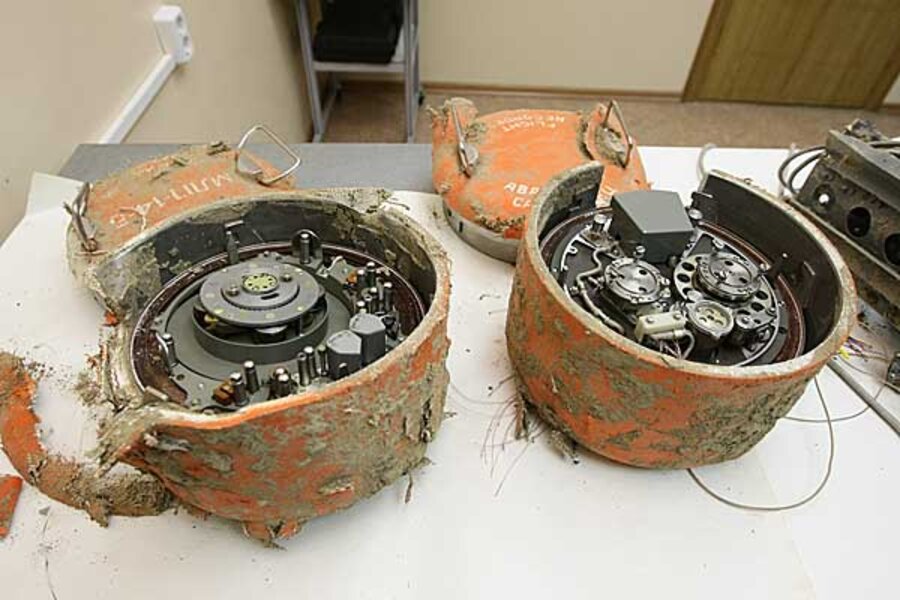Polish President Lech Kaczynski plane crash likely caused by pilot error
Loading...
| Moscow
Unauthorized people were in the cockpit and passengers were chatting on cellphones – which can interfere with navigation equipment – as the plane carrying Polish President Lech Kaczynski careened into its disastrous final approach to a Smolensk airfield in heavy fog last month, investigators say.
Preliminary findings of a joint Polish and Russian probe, released Wednesday, suggest that pilot error and irregularities aboard the doomed Tupolev Tu-154 were probably to blame for the crash that killed Mr. Kaczynski, his wife, and 95 others, including dozens of top Polish officials.
Though investigators did not offer final conclusions, they insisted that the aircraft was not brought down by technical failure or "terrorism," which may help to quell some of the Internet speculation that the tragedy might have been a KGB-style assassination of Kaczynski, who was not regarded as a friend of Russia during his time in office.
"It's very important that this investigation be seen to be transparent and impartial," says Alexei Mukhin, director of the independent Center for Political Information in Moscow. "Russian Prime Minister Vladimir Putin ordered that it be done with full openness and cooperation with the Polish authorities, because it's very important that there be no suggestion of any coverup. Putin made it clear that if any blame should be found on the Russian side, there will be punishment."
Relations between Russia and Poland, who are traditional enemies, have improved since the tragic crash, in part because both nations have come together in grief and common purpose to find the truth, says Tatiana Parkhalina, director of the independent Center for European Security in Moscow.
"It's very important that the Polish side does not have a substantially different version of the reasons for the accident" from that of Russian investigators, she says. "The probe is still going on, so we should not jump to conclusions. But at this point it looks like this terrible catastrophe has had the effect of helping Russia and Poland to turn over a new leaf in our relations."
Pilot errors
Investigators said the pilot ignored repeated warnings, including from the crew of a Polish airforce Yak-40 which had landed at Smolensk's Severny airfield earlier that day, that visibility was far below the 1,000 meter minimum generally considered necessary for a safe landing. Russian air force Lt. Gen. Alexander Alyoshin told a Moscow press conference that the plane was off-course and decending too fast during its final approach to the air strip.
"At a distance of 1.5 kilometres, the air traffic controlling group found out that the crew had increased the rate of descent and began descending below the [recommended] glide path," he said. "The chief air traffic controller ordered the crew to level out, but the crew ignored the order."
According to General Alyoshin, alarmed air traffic controllers several times ordered the plane to pull up and fly to another airport – either Minsk or Moscow – for which the Tu-154 had sufficient fuel to reach.
But the crew disobeyed those orders and continued descending, he said. "Unfortunately, it ended in a tragedy," he added.
Passengers in the cockpit
There have been repeated suggestions that the plane's pilot may have been pressured into landing by Polish officials aboard the Tu-154, who were anxious not to miss the scheduled 70th anniversary memorial of the Katyn Massacre, in which Soviet secret police murdered over 20,000 Polish military officers and intellectuals in the early months of World War Two.
That speculation is only likely to grow in the wake of revelations by investigators that at least two passengers were in the cockpit shortly before the crash and after the pilot had received warnings about low visibility.
Though the content of those flight deck conversations have not been released, the Polish PAP agency reported Thursday that one of the voices is that of the commander of Poland’s air force, Gen. Andrzej Błasik, who was aboard the plane.
However, Polish investigator Edmund Klich told journalists that the tape recordings give no impression that the pilot was being pressured to land at Smolensk.
"There is so much speculation about this crash, spanning the gamut from realistic to utterly fantastic," says Roman Gusarov, editor of the online journal Aviation.ru. "Many factors come into play in an accident like this, but the final verdict will almost certainly point to pilot error. After all, even if someone was telling the pilot to [land in defiance of warnings], the final responsibility always belongs to the pilot. No one can make decisions for him."
Related:





